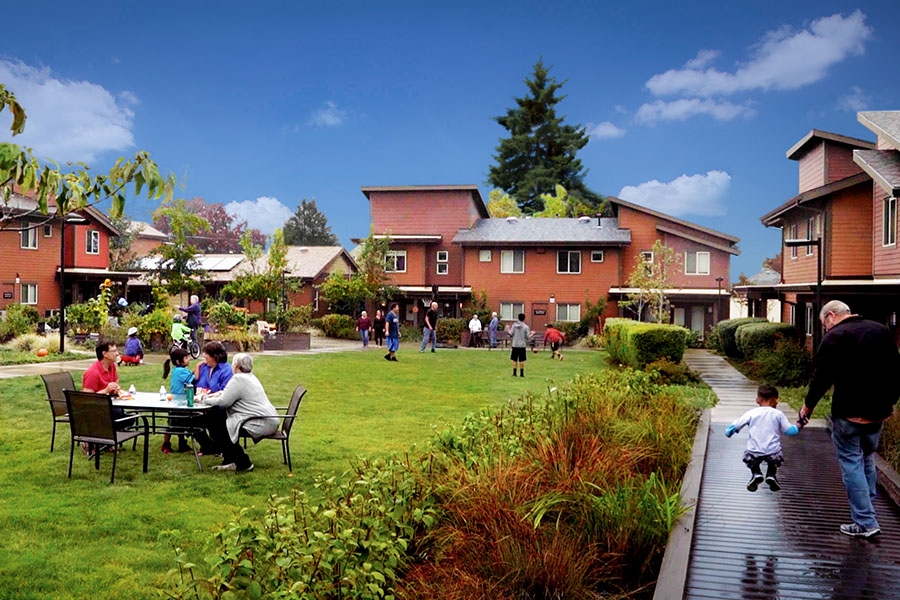Advocates suggest the threat of coronavirus makes multigenerational housing more practical, not less.
According to a 2018 study by the Pew Research Center, demand for multigenerational housing is increasing across the U.S.
Multigenerational housing is a household in which older generations, usually grandparents, live together with their adult children and grandchildren. In 2000 15% of Americans lived in a home containing two adult generations and grandchildren. In 2016 that number rose to 20%.
Supporters of multigenerational housing argue that not only is there an economic incentive for families to consolidate their wealth into one household, but having grandparents around to assist with child care, and adult children around to assist with elder care, is beneficial to everyone.
While it may seem counterintuitive for seniors to live in denser living arrangements during a pandemic, assisted-living facilities are also prone to contagion. To date half of all COVID-19-related deaths in the statewere residents of long-term care facilities.
Seniors who live on their own face a reduction in services due to COVID-19. Meal-delivery nonprofit Meals on Wheels, for example, issued an urgent call for volunteers following a large drop in drivers due to coronavirus.
According to a 2012 study from the University of California San Francisco, seniors living alone are also more likely to report persistent feelings of loneliness and isolation, which damages health.
Bandana Shrestha, community engagement director for AARP Oregon, says multigenerational housing is a much-needed third housing option for seniors. She says seniors living with family, either in their own room or in an accessory dwelling unit, provides them support and community as well as independence. The arrangement also adds child care options for parents.
“Think about all the parents who are nurses and doctors on the front lines fighting COVID and they don’t have access to child care,” she says.
Middle housing options such as duplexes and triplexes are often better situated for multigenerational living, she says, because they are not only more affordable but tend to be in more walkable areas where seniors can leave the house without relying on a car or public transportation.
“Multiple studies have shown seniors want to be able to feel independent, and living in more walkable areas supports that,” she says. “We don’t like to think about the day we won’t be able to drive but we’re all going to get there.”
Shrestha says her organization supported House Bill 2001, which allowed duplexes, triplexes and other forms of middle housing to be built on what was previously single-family-only residential zoning.
“We were very pleased with the passing of HB 2001,” she says. “There’s a significant change coming in our demographics. We are becoming more diverse and we are also aging rapidly. We need to be able to account for it with our housing options.”
Related Story: RESIDENTIAL ZONING BILL TRANSFORMS REAL ESTATE LANDSCAPE
Cultural factors may account for the gradual rise in demand for multigenerational housing.
According to the Pew study, 29% of Asian home buyers looked for multigenerational housing in 2016, as well as 27% of Hispanic and 26% of African American home buyers. Among Caucasians that number was 16%.
Derenda Schubert, executive director of Bridge Meadows, a multigenerational living nonprofit with facilities in Portland and Beaverton, says that a cultural element partially accounts for the U.S.’s slow adoption of multigenerational housing.
“There’s this belief that if you live with your parents too long there’s something not right about you, that it means you’ve failed to launch. But that’s not the truth,” says Schubert.
Schubert says she has seen the benefits of multigenerational living on display during the COVID-19 crisis.
“The elders are creating activities for kids who have to stay home in order to save lives, and the kids get to understand the importance of staying home,” says Schubert. “They know older people whose lives could be threatened by the virus. It bridges the gap between generations.”
Schubert lives in a multigenerational home herself along with her aunt. She says that her work as a psychologist helped shape her views on the benefits of multigenerational living.
“Our brains are built to be connected to one another. If more people lived multigenerationally it would make me a very happy psychologist and mom,” she says. “Kids can never have enough people loving them.”
To subscribe to Oregon Business, click here.






